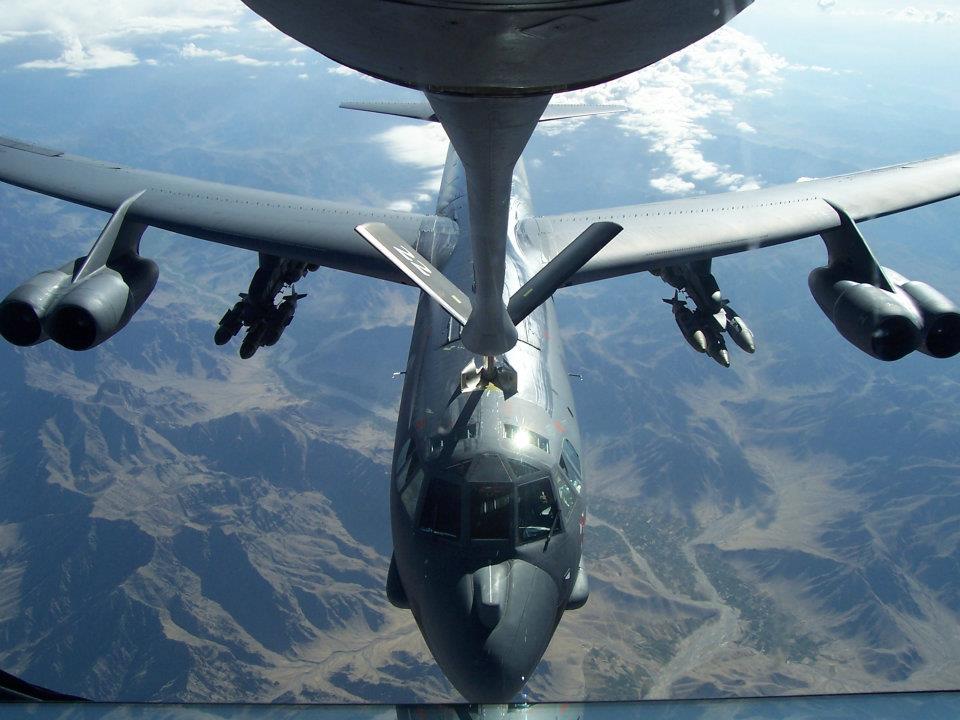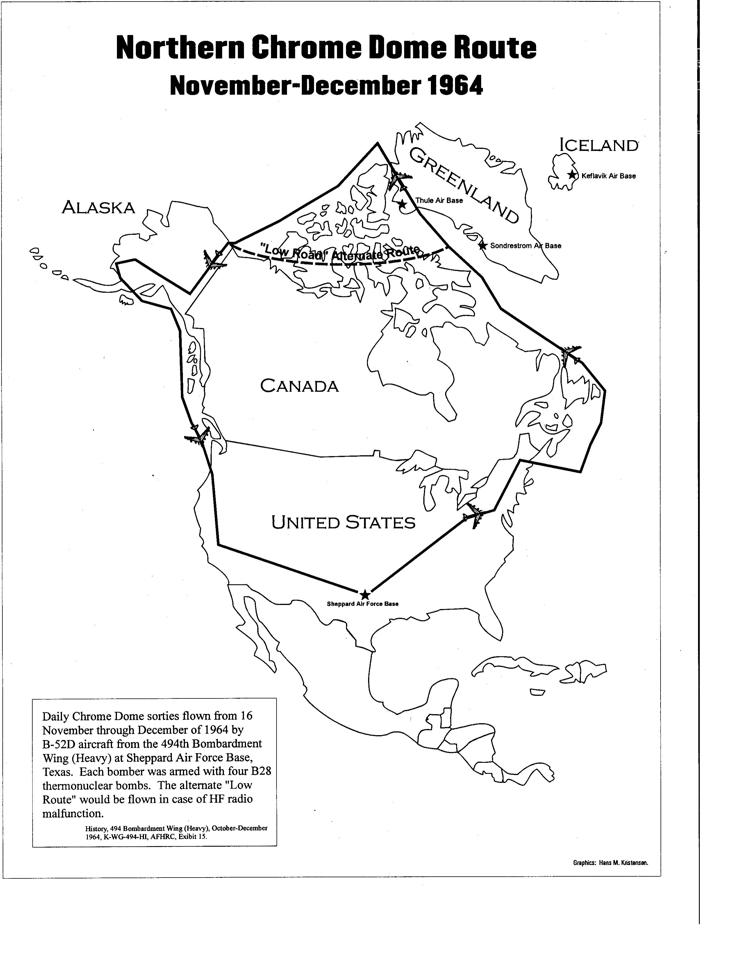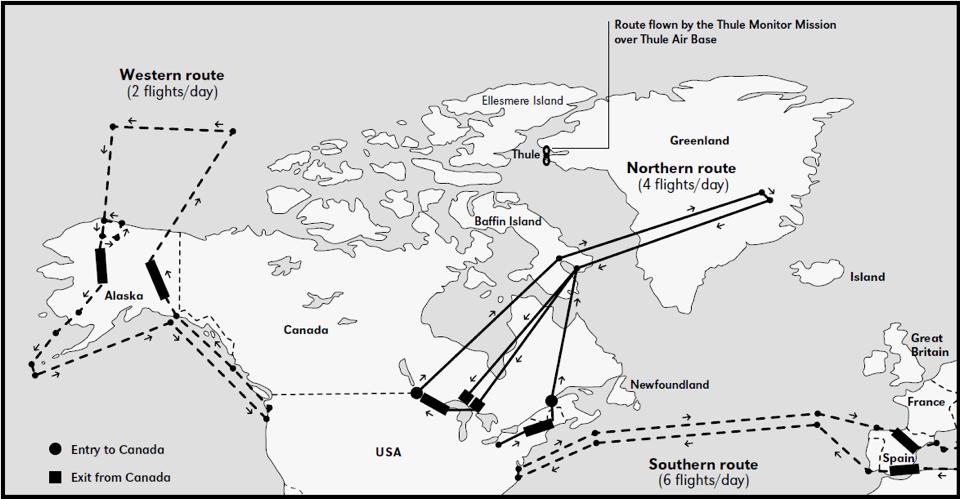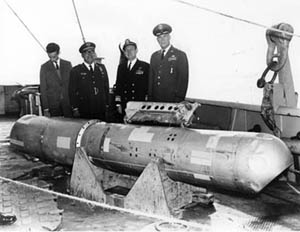It looks like you're using an Ad Blocker.
Please white-list or disable AboveTopSecret.com in your ad-blocking tool.
Thank you.
Some features of ATS will be disabled while you continue to use an ad-blocker.
9
share:
When you say the words “Chrome Dome”, most people familiar with the term will tell you it was our B-52 force on constant 24 hour airborne alert
with live nuclear weapons onboard. However there is another side of this mission. One that would have sucked more than flying all those hours in a
bomber waiting to get the “go” call. It was the large force of KC-135 Stratotankers keeping those Buff’s in flight for all those hours.
Looking back at our history, it would seem that the stratobomber and stratotanker were made for each other. Popularized by movies like “Dr. Strangelove”, air refueling with a B-52 was the easiest for a young Boom operator to accomplish. The Buff has a huge receptacle that a new boom could “slam” the boom on and let it slide into the hole (not recommended!). If you couldn’t make a contact with a B-52, chances are you would get washed out of boom school.
B-52 receptacle:

Running from 1960 to 1968, B-52’s would take off from bases like Sheppard AFB Texas, on their 24 hour mission, head towards New England, fly into the Atlantic and get some gas from the KC-135 before turning north to Greenland. From there they would fly west across the northern tip of Canada towards Alaska, refueling once again over the Pacific ocean, before turning south flying down the California coast and eastward back to Texas.
B-52 route in 1964

After a while, the Air Force must have realized that flying a bomber for that long of a duration probably had an effect on the crew members being able to cope with situational awareness and started flying three distinct routes: A western route, a northern route, and a southern route. The western route took off from the Pacific Northwest, flew over the Pacific Ocean, North through Alaska and up to the arctic before turning west towards Russia. Eventually they turned south flying through Alaska’s airspace before heading back to their home base. 2 bombers a day flew this mission. The second mission was the northern route flown by four B-52’s a day. This route started from Westover AFB, and flew north to Baffin Island. From there it went south towards Michigan, west to the Minnesota/North Dakota border, before turning north again towards Baffin island and into Greenland. And the third mission consisted of six B-52’s a day flying the southern route from Westover, across the Atlantic, into the Med, and back. One of Americas most famous “broken arrows” occurred on this route in 1966 in Palomares, Spain.

For those who don’t know the term, broken arrow is a term used by the military when they lose a nuclear bomb. Paraphrasing this articleon Jan 16, 1966, a B-52G with the call sign Tea 16 left Seymour Johnson AFB enroute to its orbit near Turkey. On the third air refueling of the mission, the bomber was moving too fast on the tanker and the boom hit the buff’s longeron, consequently ripping the left wing off the aircraft.
Four nuclear weapons were released in the accident. Three were found with the wreckage of the B-52 near Palomares, Spain. The fourth was declared a broken arrow. One of the first three released plutonium, and the USAF sent in teams to haul away the radioactive dirt that surround the area. The forth bomb resulted in one of the greatest search and rescue operations for a nuclear weapon in the history of the country. Over thirty ships and submersible vehicle Alvin search the sea floor for 11 weeks before finally bringing the bomb aboard the USS Petrel on April 7th. The Mk 28 bomb was immediately sanitized for the media (covering up serial numbers and markings which was ordered by then SecDef Robert S. McNamara) before Spanish officials inspected the bomb and the press took pictures.
Mk 28 Nuclear Bomb

Chrome Dome was more than just a nuclear airborne alert force. It was a deterrence. The missions were not a secret: we wanted the USSR to know we were flying them. During the 1962 Cuban Missile Crises, as many as 75 nuclear armed B-52s were airborne a day, about 20 percent of the bomber force. But behind every flight a buff made were several tankers offloading hundreds of thousands of pounds of fuel every flight.
Most boom operators like to have a so called checklist or bucket list of things they like to accomplish before leaving the career. For instance, on these Chrome Dome flights, boom operators would knock out the 100,000 pound offload in one flight, or 100,000 pound offload in one contact (takes around 20 minutes!). Another that happened on these flights was the 1 million pound total offload mark, which booms were hitting in about 10 flights.
Air refuelings on Chrome Dome were usually conducted by crews deployed to Eielson AFB, Alaska, Torrejon Air Base and Moron Air Base in Spain, and home bases located along the north eastern US. Here’s an excerpt from “TOF” on his blog located here
Looking back at our history, it would seem that the stratobomber and stratotanker were made for each other. Popularized by movies like “Dr. Strangelove”, air refueling with a B-52 was the easiest for a young Boom operator to accomplish. The Buff has a huge receptacle that a new boom could “slam” the boom on and let it slide into the hole (not recommended!). If you couldn’t make a contact with a B-52, chances are you would get washed out of boom school.
B-52 receptacle:

Running from 1960 to 1968, B-52’s would take off from bases like Sheppard AFB Texas, on their 24 hour mission, head towards New England, fly into the Atlantic and get some gas from the KC-135 before turning north to Greenland. From there they would fly west across the northern tip of Canada towards Alaska, refueling once again over the Pacific ocean, before turning south flying down the California coast and eastward back to Texas.
B-52 route in 1964

After a while, the Air Force must have realized that flying a bomber for that long of a duration probably had an effect on the crew members being able to cope with situational awareness and started flying three distinct routes: A western route, a northern route, and a southern route. The western route took off from the Pacific Northwest, flew over the Pacific Ocean, North through Alaska and up to the arctic before turning west towards Russia. Eventually they turned south flying through Alaska’s airspace before heading back to their home base. 2 bombers a day flew this mission. The second mission was the northern route flown by four B-52’s a day. This route started from Westover AFB, and flew north to Baffin Island. From there it went south towards Michigan, west to the Minnesota/North Dakota border, before turning north again towards Baffin island and into Greenland. And the third mission consisted of six B-52’s a day flying the southern route from Westover, across the Atlantic, into the Med, and back. One of Americas most famous “broken arrows” occurred on this route in 1966 in Palomares, Spain.

For those who don’t know the term, broken arrow is a term used by the military when they lose a nuclear bomb. Paraphrasing this articleon Jan 16, 1966, a B-52G with the call sign Tea 16 left Seymour Johnson AFB enroute to its orbit near Turkey. On the third air refueling of the mission, the bomber was moving too fast on the tanker and the boom hit the buff’s longeron, consequently ripping the left wing off the aircraft.
Four nuclear weapons were released in the accident. Three were found with the wreckage of the B-52 near Palomares, Spain. The fourth was declared a broken arrow. One of the first three released plutonium, and the USAF sent in teams to haul away the radioactive dirt that surround the area. The forth bomb resulted in one of the greatest search and rescue operations for a nuclear weapon in the history of the country. Over thirty ships and submersible vehicle Alvin search the sea floor for 11 weeks before finally bringing the bomb aboard the USS Petrel on April 7th. The Mk 28 bomb was immediately sanitized for the media (covering up serial numbers and markings which was ordered by then SecDef Robert S. McNamara) before Spanish officials inspected the bomb and the press took pictures.
Mk 28 Nuclear Bomb

Chrome Dome was more than just a nuclear airborne alert force. It was a deterrence. The missions were not a secret: we wanted the USSR to know we were flying them. During the 1962 Cuban Missile Crises, as many as 75 nuclear armed B-52s were airborne a day, about 20 percent of the bomber force. But behind every flight a buff made were several tankers offloading hundreds of thousands of pounds of fuel every flight.
Most boom operators like to have a so called checklist or bucket list of things they like to accomplish before leaving the career. For instance, on these Chrome Dome flights, boom operators would knock out the 100,000 pound offload in one flight, or 100,000 pound offload in one contact (takes around 20 minutes!). Another that happened on these flights was the 1 million pound total offload mark, which booms were hitting in about 10 flights.
Air refuelings on Chrome Dome were usually conducted by crews deployed to Eielson AFB, Alaska, Torrejon Air Base and Moron Air Base in Spain, and home bases located along the north eastern US. Here’s an excerpt from “TOF” on his blog located here
I supported Operation Chrome Dome from both Eielson AFB and from Torrejon AB. I also deployed once to Griffiss AFB in January 1962. The deployment to Torrejon was a pleasure trip; the deployment to Eielson was, in the summer months, tolerable duty; however, winter flying from Eielson was a test of men and equipment. During the winter months the air temperature routinely hovered around -25º F. Everything was cold soaked and it was hard to warm the aircraft up after they had sat idle for more than a few hours. Hydraulic leaks were common as seals hardened and cracked. Windows, especially cockpit windows often broke as the intense cold caused the aluminum window frames to contract and overstress the window panes.
The routine for deployed tanker crews was to conduct several air refuelings on the Cold Coffee route, which ran from Fort Yukon straight south to a point abeam Big Delta, Alaska. The B-52s would receive an on load of about 100,000 pounds of fuel in about 20 minutes. The bombers would then proceed along their planned route to their home base, after some six or seven hours more of flying time. The tankers cleared the Cold Coffee air refueling track to the right and made an immediate descent and landing at Eielson AFB. If the pace of operations warranted, the tanker crews could make one or two more air refueling sorties on the Cold Coffee Route before calling it a day.
There was also at least one Hard Head sortie, which meant that the tanker crew would fly to the vicinity of Thule Air Base, Greenland and refuel a B-52 assigned to keep watch on the Thule BMEWS radar site. It was a boring job. If for any reason the B-52 was unable to take on sufficient fuel or had other problems that warranted aborting the sortie, the tanker crew was required to perform the Thule Monitor mission until relieved by the next B-52 coming from the United States. I flew exactly two Hard Head sorties on my two deployments to Eielson; the first, done in daylight, went as planned. The second, done in the February darkness of mid-winter was not quite as smooth but we got the fuel offloaded and didn't have to fly the Thule Monitor mission. Those who did fly Thule Monitor told me that it was one of the most boring things they have ever done.
This was just a quick history lesson of Operation Chrome Dome and an example of what America is capable of doing during a time of nuclear war. The KC-135 Stratotanker has proven itself time and time again as the work horse tanker of the Air Force and the rest of the world. Without this technology, missions like Chrome Dome would not have been possible. Having spent six years of my life as a boom operator, I know how important it is to have that tanker support, whether it be for a nuclear mission over the arctic, a CAP mission in Afghanistan, or the first night of an all-out Shock and Awe campaign in Iraq. Without tankers, America wouldn’t be the superpower that it is today.
Tankers are the lifeline of the Force. I've watched F-16s sit there for 88 days waiting on a tanker going the right direction that could take them
where they needed to go. I've also seen fighters literally dragged to where they were going because they had such bad fuel leaks. We had an F-16
flight coming in and had to scramble one of our EC-135s on a ready alert launch because the tanker dragging them didn't have enough fuel to get all 6
of them to Hickam, because one was dumping as much fuel overboard as they could pump into it. The EC ended up bringing 5 in, while the 6th locked
onto the boom of the tanker dragging them, and was literally dragged to the point where he could detach from the boom and land.
I'm always amazed at how the leadership won't hesitate to spend billions of dollars on that shiny new fighter that is somehow going to single handedly win the war, while completely ignoring the 50+ year old tankers and bombers, without which, those shiny fighters are going to be sitting on the ground thousands of miles away, trying to get to the fight.
I'm always amazed at how the leadership won't hesitate to spend billions of dollars on that shiny new fighter that is somehow going to single handedly win the war, while completely ignoring the 50+ year old tankers and bombers, without which, those shiny fighters are going to be sitting on the ground thousands of miles away, trying to get to the fight.
Chrome Dome on the Bomber side was a beast to deal with. The tanker crews were lucky in that they only had to meet the bombers and offload fuel into
them, then land. The maintenance guys would spend days going over the bombers prior to each launch, and again after each landing. They had to find
every minor problem and make sure it was fixed.
Twenty four hours in flight is something that planes are designed to do. It puts a great strain on the aircraft, and more on the crews, considering that the B-52 didn't have a true bunk setup. At least it had a toilet.
There were some close calls on these missions, brought about by systems being tasked to perform more than they were supposed to. If I remember correctly, there were a couple of birds that made emergency landings due to fires on board, after electrical systems shorted, as well as several that lost engines during flight. It was nerve wracking for the crews and the maintenance personnel involved in these missions.
Twenty four hours in flight is something that planes are designed to do. It puts a great strain on the aircraft, and more on the crews, considering that the B-52 didn't have a true bunk setup. At least it had a toilet.
There were some close calls on these missions, brought about by systems being tasked to perform more than they were supposed to. If I remember correctly, there were a couple of birds that made emergency landings due to fires on board, after electrical systems shorted, as well as several that lost engines during flight. It was nerve wracking for the crews and the maintenance personnel involved in these missions.
a reply to: Zaphod58
That is a crazy thing to think about, an aerial towing operation. I can not imagine being a boom operator on one of those missions. Would the boom have to be manned the whole flight? If so that sounds very tedious and stressful, not a job for this guy. Come to think of it, not really sure I would like to be flying around in a flying gas tank where the windows fall out either. But an amazing story none the less
That is a crazy thing to think about, an aerial towing operation. I can not imagine being a boom operator on one of those missions. Would the boom have to be manned the whole flight? If so that sounds very tedious and stressful, not a job for this guy. Come to think of it, not really sure I would like to be flying around in a flying gas tank where the windows fall out either. But an amazing story none the less
a reply to: HiMyNameIsCal
Yeah, he had to be on the boom the whole time, monitoring things. He was wiped when they landed.
Yeah, he had to be on the boom the whole time, monitoring things. He was wiped when they landed.
a reply to: HiMyNameIsCal
In Afghanistan, an f-18 was hit and was loosing fuel bad. He stayed on my boom for three and a half hours until he could glide back into the base. If you think its hard trying to keep a boom steady that long, imagine trying to keep a drogue steady for that long.
In Afghanistan, an f-18 was hit and was loosing fuel bad. He stayed on my boom for three and a half hours until he could glide back into the base. If you think its hard trying to keep a boom steady that long, imagine trying to keep a drogue steady for that long.
a reply to: boomer135
Wow, so this is a regular occurrence eh? That is pretty dang cool! Flying a damaged aircraft while attached to a boom must be something else entirely, especially if the pilot were injured. what is the biggest offload you've done and what is the biggest plane that a KC-135 can "drag"?
Wow, so this is a regular occurrence eh? That is pretty dang cool! Flying a damaged aircraft while attached to a boom must be something else entirely, especially if the pilot were injured. what is the biggest offload you've done and what is the biggest plane that a KC-135 can "drag"?
new topics
-
Judge rules president-elect Donald Trump must be sentenced in 'hush money' trial
US Political Madness: 5 hours ago -
Farmers wife
Music: 7 hours ago -
NJ Drones tied to Tesla explosion at Trump Las vegas
General Conspiracies: 8 hours ago -
New Jersey-Teachers Can Now Be Certified Without Passing Basic Reading Writing Math Testing
Education and Media: 11 hours ago
top topics
-
Matthew Livelsberger said he was being followed by FBI
Political Conspiracies: 14 hours ago, 16 flags -
How the Sikhs Deal with Muslim Grooming Gangs – Tommy Robinson
Social Issues and Civil Unrest: 16 hours ago, 7 flags -
New Jersey-Teachers Can Now Be Certified Without Passing Basic Reading Writing Math Testing
Education and Media: 11 hours ago, 7 flags -
Paranoid Liberals Believe U.S. Service Members are More Dangerous than Illegal Aliens.
Social Issues and Civil Unrest: 17 hours ago, 6 flags -
NJ Drones tied to Tesla explosion at Trump Las vegas
General Conspiracies: 8 hours ago, 5 flags -
Farmers wife
Music: 7 hours ago, 1 flags -
Judge rules president-elect Donald Trump must be sentenced in 'hush money' trial
US Political Madness: 5 hours ago, 1 flags
active topics
-
Petition Calling for General Election at 564,016 and rising Fast
Political Issues • 196 • : angelchemuel -
UK Borders are NOT Secure!
Social Issues and Civil Unrest • 22 • : angelchemuel -
Grenfell Tower Fire revisited
Mainstream News • 9 • : angelchemuel -
Tesla Cybertruck Explodes in Front of Trump Hotel in Las Vegas
Mainstream News • 200 • : gortex -
How the Sikhs Deal with Muslim Grooming Gangs – Tommy Robinson
Social Issues and Civil Unrest • 4 • : xWorldxGonexMadx -
FIEND SLASHED: Sara Sharif’s killer dad ‘has neck & face sliced open with jagged tuna tin lid
Mainstream News • 19 • : gortex -
Here we again... CHINA having mass outbreak of something
Diseases and Pandemics • 18 • : xWorldxGonexMadx -
Musk calls on King Charles III to dissolve Parliament over Oldham sex grooming gangs
Mainstream News • 91 • : bastion -
Candidate TRUMP Now Has Crazy Judge JUAN MERCHAN After Him - The Stormy Daniels Hush-Money Case.
Political Conspiracies • 2174 • : network dude -
Judge rules president-elect Donald Trump must be sentenced in 'hush money' trial
US Political Madness • 4 • : Lazy88
9
